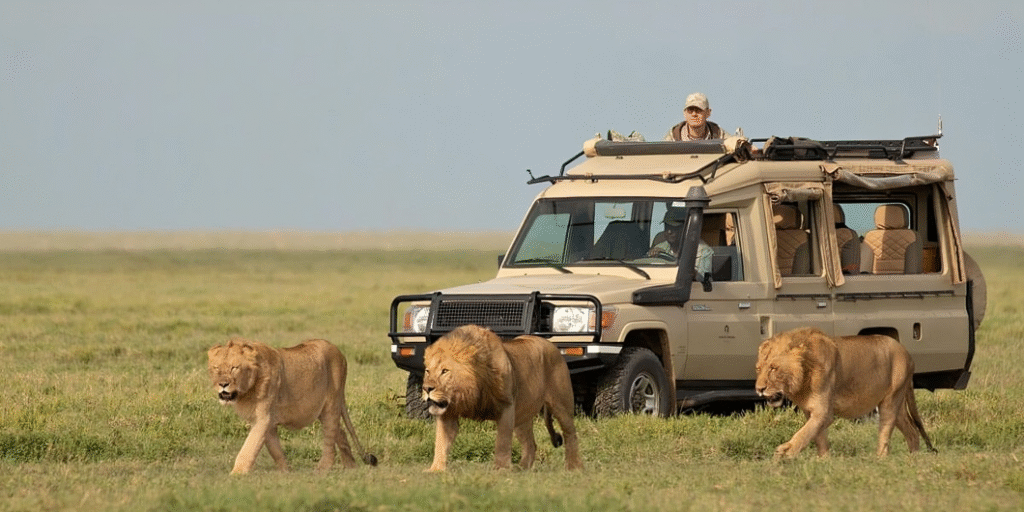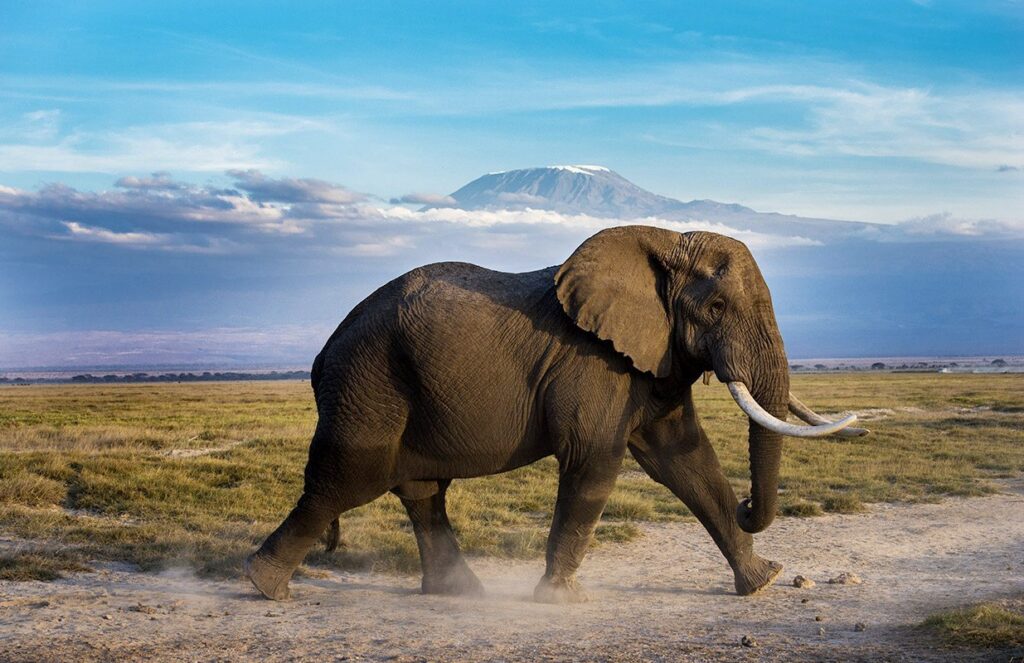- The best safari tours in Tanzania and Kenya combine iconic destinations like Serengeti, Ngorongoro Crater, Maasai Mara, and Amboseli.
- Ideal trip length: 7–14 days, depending on how many parks and reserves you want to explore.
- Perfect for witnessing the Great Migration (July–October in Maasai Mara; December–March in Serengeti).
- A combined safari gives travelers a chance to see the Big Five, cultural Maasai experiences, and diverse landscapes.
- Best ways to travel: guided overland safaris, luxury fly-in safaris, or tailor-made private tours.
Why Combine Tanzania and Kenya Safaris?
When people dream of an African safari, two destinations almost always top the list: Tanzania and Kenya. Both countries are home to some of the most spectacular wildlife reserves in the world. But here’s the magic—when you combine the two into one itinerary, you unlock the ultimate safari adventure.
Imagine starting your journey in Tanzania’s Serengeti, where millions of wildebeest thunder across the plains, then crossing the border into Kenya’s Maasai Mara, where predators like lions and cheetahs wait in anticipation. Add in the Ngorongoro Crater, a natural wonder teeming with animals, and the breathtaking backdrop of Mount Kilimanjaro in Amboseli, and you’ve got an itinerary that feels straight out of a documentary.
In this guide, we’ll explore the best safari tours in Tanzania and Kenya, covering top parks, sample itineraries, best times to visit, and tips for planning a seamless trip.
Top Safari Destinations in Tanzania
1. Serengeti National Park
The Serengeti is world-famous for the Great Wildebeest Migration, often called the “greatest wildlife show on Earth.” Picture millions of wildebeest, zebras, and gazelles on the move, with predators lurking nearby. Depending on the season, you can witness dramatic river crossings, calving seasons, or massive herds grazing the golden plains.
Highlights:
- The Big Five (lion, leopard, rhino, elephant, buffalo).
- Best spot for cheetah sightings.
- Hot-air balloon safaris at sunrise.
Best Time to Visit: December–March (calving season) and June–September (river crossings).

2. Ngorongoro Crater
Known as the “Eighth Wonder of the World,” the Ngorongoro Crater is a UNESCO World Heritage Site. It’s essentially a natural zoo—over 25,000 animals live in the crater year-round, making it one of the most reliable places to spot wildlife.
Highlights:
- Chance to see the endangered black rhino.
- Dense predator population (especially lions).
- Scenic views of the crater rim.
Best Time to Visit: Year-round, but dry season (June–October) is best for easy game viewing.

3. Tarangire National Park
If you love elephants, Tarangire is a must. Known for its huge elephant herds and iconic baobab trees, it offers a more tranquil safari compared to Serengeti and Ngorongoro.
Highlights:
- Giant elephant herds (sometimes 200+ strong).
- Excellent birdwatching with over 500 species.
- Baobab-filled landscapes.
Best Time to Visit: June–October during the dry season.
Top Safari Destinations in Kenya
4. Maasai Mara National Reserve
The Maasai Mara is Kenya’s crown jewel. It’s the northern extension of Tanzania’s Serengeti, making it the perfect complement to a cross-border safari. Every year, between July and October, the Mara hosts the dramatic wildebeest river crossings at the Mara River.
Highlights:
- Best place to see lion prides in Africa.
- Dramatic predator-prey interactions.
- Rich Maasai culture and cultural tours.
Best Time to Visit: July–October for the Great Migration.

5. Amboseli National Park
Amboseli is often called the “Land of Giants” because of its massive elephant herds. What makes it truly spectacular is the backdrop—Mount Kilimanjaro, Africa’s tallest peak, often covered in snow.
Highlights:
- Close encounters with elephants.
- Stunning photography with Kilimanjaro in the background.
- Birdwatching paradise.
Best Time to Visit: June–October and January–February for clear views of Kilimanjaro.

Sample Combined Safari Itineraries
7-Day Tanzania & Kenya Safari
- Day 1-2: Serengeti National Park (game drives & optional balloon safari).
- Day 3: Ngorongoro Crater (crater tour & overnight on the rim).
- Day 4-5: Maasai Mara (wildebeest migration & predator sightings).
- Day 6: Maasai village visit + game drive.
- Day 7: Amboseli (elephants & Kilimanjaro views).
10-Day Luxury Safari Tour
- Serengeti → Ngorongoro → Lake Manyara → Maasai Mara → Amboseli.
- Stay in luxury lodges & tented safari camps with private guides.
14-Day Grand Safari Experience
- Covers all major parks in Tanzania and Kenya. Perfect for those wanting a once-in-a-lifetime trip.
Best Time for a Tanzania-Kenya Safari
- June–October: Dry season, easier wildlife viewing, Great Migration river crossings.
- November–December: Short rains but still good for game drives.
- January–March: Calving season in the Serengeti (great for predator action).
- April–May: Long rains (less ideal, some lodges close).
Tips for Planning the Best Safari Tours in Tanzania and Kenya
- Choose the right safari style: Budget camping, mid-range lodges, or luxury fly-in safaris.
- Book early: Migration season is peak season; lodges fill fast.
- Cross-border logistics: Consider flights or guided transfers between Serengeti and Maasai Mara.
- Pack smart: Lightweight clothes, binoculars, insect repellent, and a good camera.
- Go with a reputable operator: Look for experienced guides who understand migration patterns.
Conclusion
A combined Tanzania and Kenya safari is hands-down the best way to experience Africa’s wildlife. You’ll witness the Great Migration, see the Big Five, interact with Maasai culture, and explore some of the most beautiful landscapes on Earth. Whether you have 7, 10, or 14 days, the best safari tours in Tanzania and Kenya guarantee an unforgettable adventure.
How many days do I need for a Tanzania and Kenya safari?
At least 7 days, but 10–14 days allows for a more relaxed and complete experience.
What’s the best month to see the Great Migration?
July–October: Mara River crossings in Kenya.
December–March: Calving season in Serengeti.
Can I do a budget safari across both countries?
Yes, many operators offer camping safaris or budget-friendly lodges.
Do I need separate visas for Tanzania and Kenya?
Yes, but you can get an East Africa Tourist Visa covering Kenya, Uganda, and Rwanda (not Tanzania), so you’ll still need a Tanzania visa separately.
Which safari is better—Tanzania or Kenya?
Both are spectacular. Tanzania offers larger parks, while Kenya has more concentrated wildlife viewing. A combined safari gives you the best of both worlds.